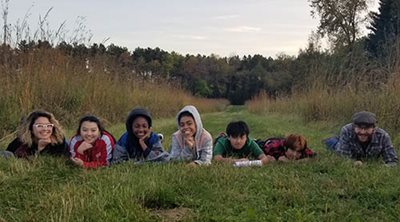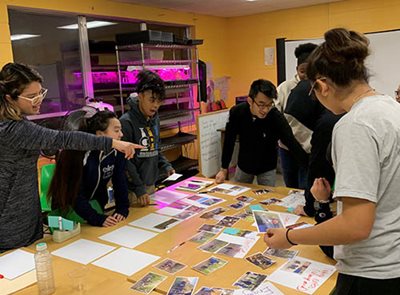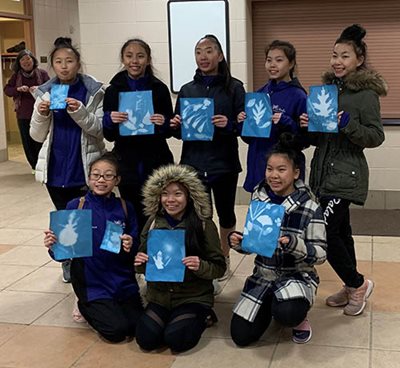 The regional parks in the Twin Cities metro area — treasures in the natural landscape — draw visitors more than 60 million times a year. But not everyone.
The regional parks in the Twin Cities metro area — treasures in the natural landscape — draw visitors more than 60 million times a year. But not everyone.
Often missing are young people in their early and late teens. “Connecting these young people with the regional parks is crucial,” said research sociologist Darcie Vandergrift, in our Community Development division.
“Most important, it’s a question of supporting adolescent development and creating racial equity in regional park access,” she said. “But it’s also important to help build support for the regional parks in the future. By 2040, young people of color in the metro area will account for 53% of all our residents under age 18.”

Youth and parks staff collaborate on research
A research collaboration led by Vandegrift examined the park-related needs and preferences of youth, as well as obstacles they face in accessing and using the parks. Prioritizing perspectives from young people of color, Met Council staff and youth participants together conducted research to understand the factors involved in connecting youth with the outdoors. The project identified potential opportunities for the region’s park implementing agencies to reduce barriers and consider efforts to broaden youth and family activities.
The Met Council was lead partner of the research team, which included members of youth-serving community organizations and professional staff of four park agencies — Dakota County, Ramsey County, Washington County, and Three Rivers Park District.
Participating in the project was a large group of Twin Cities youth, plus their group leaders and parents — 70 in all — from an extensive list of organizations in the Twin Cities area. They included Asian Media Access, Organization of Liberians in Minnesota, Outdoor Latino Minnesota, Minnesota Scout Troop 100, Urban Roots MN, and Three Rivers Park District Teen Council.
“Together, our team used various qualitative methods to analyze best practices for connecting young people age 13 – 20 with all the regional park system has to offer,” said Vandegrift. “Youth researchers analyzed parks through various field activities and experiences along with conversations to hear their thoughts and reactions.”
Much of the analysis and interviews were done by youth researchers collaborating in the project. “Youth took photos of features and activities they found fun and interesting, and they identified the ones that meant the most to them. We came together in youth-led discussions and creative activities to confirm and revise tentative conclusions we as Council researchers had drawn.”

Participants uncover concerns and enjoyment about parks
The findings cover a broad range of issues, expressed by youth as well as supportive adults from the participating organizations:
- Concerns about personal safety
- Lack of opportunity to learn outdoor skills
- Experiences of racist encounters in the parks
- Lack of accommodation to cultural preferences
- Economic hardships of families
- For youth in particular, busy lives and constraints on both time and transportation to the parks
But youth participants were vocal about what they liked. “I felt cool and adventurous being in the woods,” one youth recounted.
Parents could see the benefits as well. A father who often took his children camping reflected, “Kids in nature have a lot of confidence. That adds to confidence in other areas, like school.” And from another parent: “With the kids socializing outdoors, you see a change. They are happier. They get back to the house different people.”
“The youth identified a dozen different activities they enjoyed in the parks,” said Vandegrift. “They liked exploring the displays and artifacts of the nature centers. They were interested in learning about the cultural history of the park area, going out on hikes, taking a photography class, and going on nature walks where they learned more about the park environment. Of course, they also liked the bonfires with s’mores, pick-up ball games on the open fields,” she said, “and the time they had for free play.”
The adults who accompanied the youth suggested that the parks incorporate a broader cultural perspective that reflected connections with their own origins and experience — for example, similarities of animal species.

Recommendations for action
Vandegrift said the project identified several avenues where the implementing agencies and the Met Council can take steps to better connect youth to the outdoors:
- Create opportunities for youth to design and implement in-park activities.
- Build relationships and partnerships with youth-serving organizations and other interested groups.
- Participate in creating solutions to overcome obstacles than hinder youth from visiting and enjoying the parks.
- Work toward expanding the racial and ethnic mix of park staff, programming, and research, as well as initiating dialogue with youth-serving organizations.
- Expand programming and outreach that respond to prior experiences of the youth that reflect their interactions within their community and with the world.
“These steps can be taken with the authority that the implementing agencies and the Met Council already have,” said Vandegrift. The agencies can consider what the study’s implications may be for their funding, policies, and planning, as well as their “on-the-ground” efforts involving park programming and community outreach.
The Met Council, she said, can play a convening role with the implementing agencies and the community organizations to develop strategies and address barriers to move forward. Vandegrift and the Met Council research team have presented to implementing agency staff, and parks and open spaces commissions, as well as other interested entities. The Met Council’s review of park long-term plans can work toward incorporating youth and multi-cultural perspectives, she added, and the Met Council could consider further park-related research with community organizations and others.
“Our research offers perspectives on how we could work together toward a more inclusive and equitable regional park system,” said Vandegrift, “and it can potentially support efforts to bring more people to our amazing regional parks.”
Adventure Close to Home: Connecting Youth to the Regional Park System
About regional parks and trails
Met Council’s role in regional parks and trails
Park partner agencies